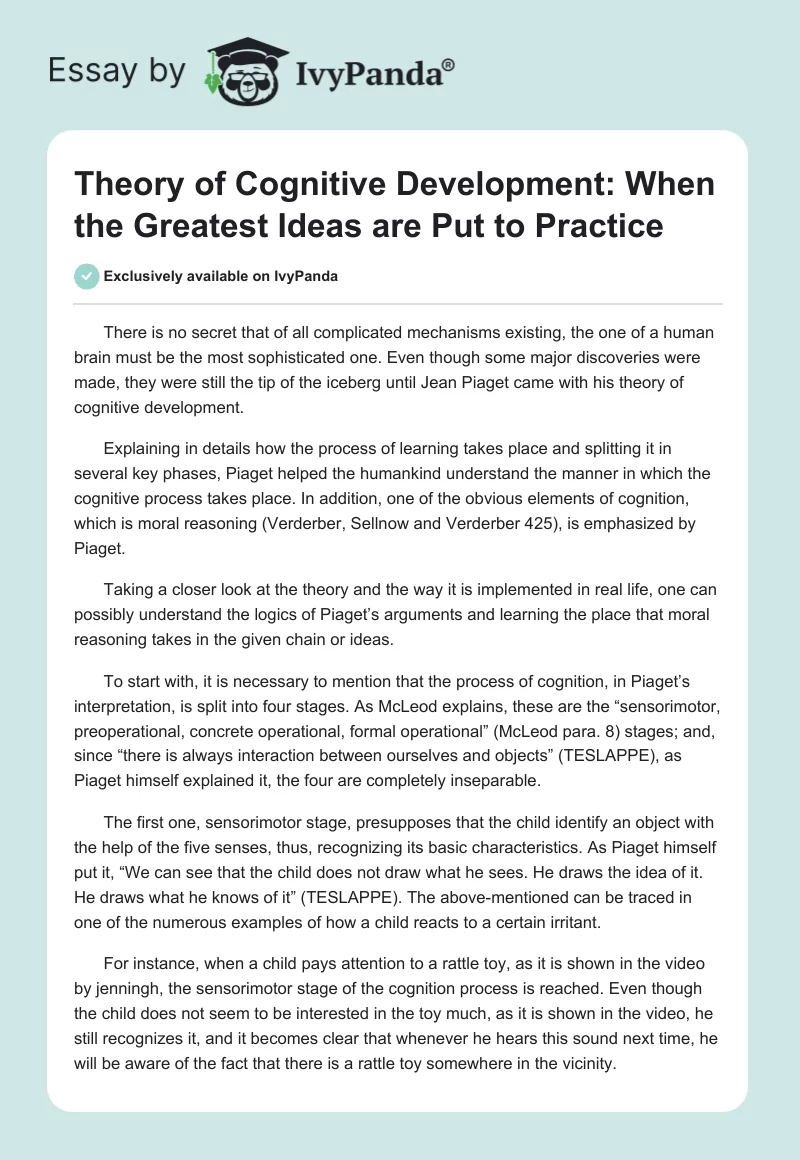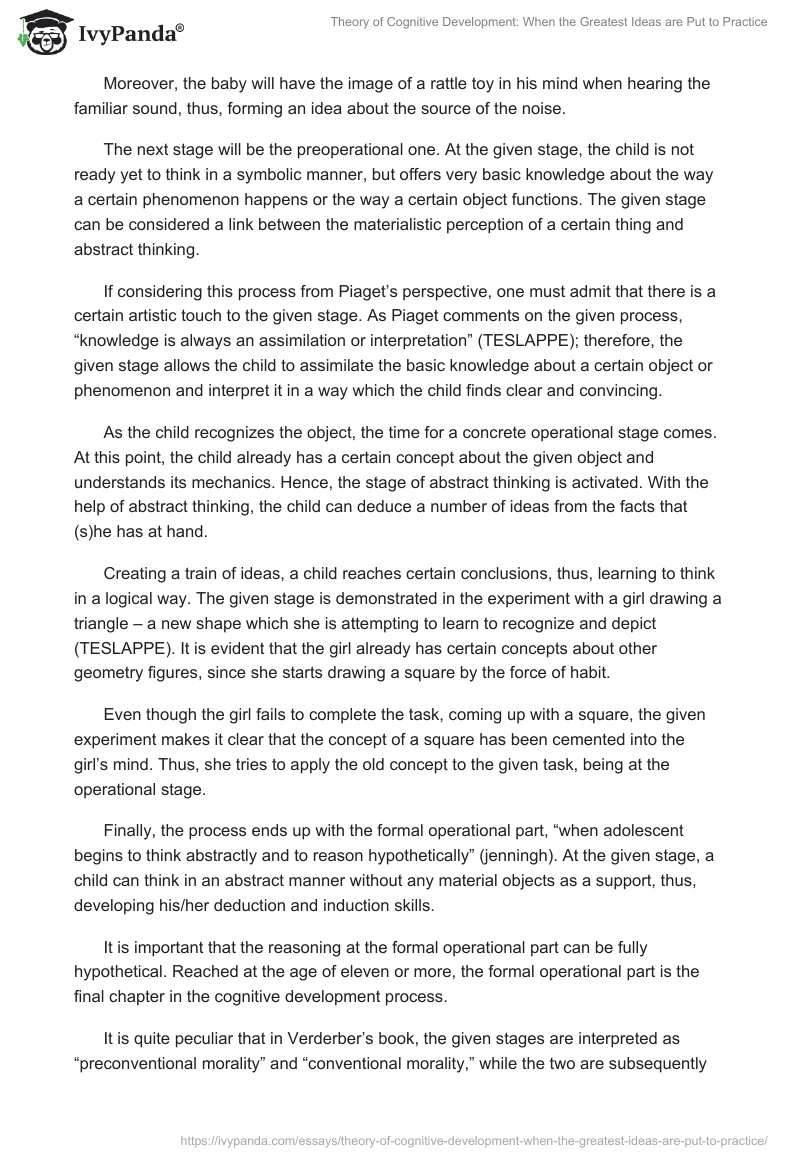There is no secret that of all complicated mechanisms existing, the one of a human brain must be the most sophisticated one. Even though some major discoveries were made, they were still the tip of the iceberg until Jean Piaget came with his theory of cognitive development.
Explaining in details how the process of learning takes place and splitting it in several key phases, Piaget helped the humankind understand the manner in which the cognitive process takes place. In addition, one of the obvious elements of cognition, which is moral reasoning (Verderber, Sellnow and Verderber 425), is emphasized by Piaget.
Taking a closer look at the theory and the way it is implemented in real life, one can possibly understand the logics of Piaget’s arguments and learning the place that moral reasoning takes in the given chain or ideas.
To start with, it is necessary to mention that the process of cognition, in Piaget’s interpretation, is split into four stages. As McLeod explains, these are the “sensorimotor, preoperational, concrete operational, formal operational” (McLeod para. 8) stages; and, since “there is always interaction between ourselves and objects” (TESLAPPE), as Piaget himself explained it, the four are completely inseparable.
The first one, sensorimotor stage, presupposes that the child identify an object with the help of the five senses, thus, recognizing its basic characteristics. As Piaget himself put it, “We can see that the child does not draw what he sees. He draws the idea of it. He draws what he knows of it” (TESLAPPE). The above-mentioned can be traced in one of the numerous examples of how a child reacts to a certain irritant.
For instance, when a child pays attention to a rattle toy, as it is shown in the video by jenningh, the sensorimotor stage of the cognition process is reached. Even though the child does not seem to be interested in the toy much, as it is shown in the video, he still recognizes it, and it becomes clear that whenever he hears this sound next time, he will be aware of the fact that there is a rattle toy somewhere in the vicinity.
Moreover, the baby will have the image of a rattle toy in his mind when hearing the familiar sound, thus, forming an idea about the source of the noise.
The next stage will be the preoperational one. At the given stage, the child is not ready yet to think in a symbolic manner, but offers very basic knowledge about the way a certain phenomenon happens or the way a certain object functions. The given stage can be considered a link between the materialistic perception of a certain thing and abstract thinking.
If considering this process from Piaget’s perspective, one must admit that there is a certain artistic touch to the given stage. As Piaget comments on the given process, “knowledge is always an assimilation or interpretation” (TESLAPPE); therefore, the given stage allows the child to assimilate the basic knowledge about a certain object or phenomenon and interpret it in a way which the child finds clear and convincing.
As the child recognizes the object, the time for a concrete operational stage comes. At this point, the child already has a certain concept about the given object and understands its mechanics. Hence, the stage of abstract thinking is activated. With the help of abstract thinking, the child can deduce a number of ideas from the facts that (s)he has at hand.
Creating a train of ideas, a child reaches certain conclusions, thus, learning to think in a logical way. The given stage is demonstrated in the experiment with a girl drawing a triangle – a new shape which she is attempting to learn to recognize and depict (TESLAPPE). It is evident that the girl already has certain concepts about other geometry figures, since she starts drawing a square by the force of habit.
Even though the girl fails to complete the task, coming up with a square, the given experiment makes it clear that the concept of a square has been cemented into the girl’s mind. Thus, she tries to apply the old concept to the given task, being at the operational stage.
Finally, the process ends up with the formal operational part, “when adolescent begins to think abstractly and to reason hypothetically” (jenningh). At the given stage, a child can think in an abstract manner without any material objects as a support, thus, developing his/her deduction and induction skills.
It is important that the reasoning at the formal operational part can be fully hypothetical. Reached at the age of eleven or more, the formal operational part is the final chapter in the cognitive development process.
It is quite peculiar that in Verderber’s book, the given stages are interpreted as “preconventional morality” and “conventional morality,” while the two are subsequently splits into two stages each (Verderber, Sellnow and Verderber). Hence, the four elements of the idea remain in their places, but the shape in which they are offered is changed a bit.
A Report on a Piagetian Experiment
To demonstrate the concept of the cognition theory and show the way it works when being put into practice, the following experiment was conducted. Three people were picked to answer a certain question. The first participant was a four-year-old boy who referred to himself as “me” and “Jim”, the second one was a twelve-year-old girl, and the third one was a nineteen-year-old man.
The people mentioned above were offered a single question to answer, namely, “What if people didn’t have thumbs?” The latter made a joke, “Then we wouldn’t know how to rate comments on YouTube.” The girl answered, “I don’t know.” Meanwhile, the boy nearly cried in fear, imagining the consequences.
Analyzing the results which have been derived from the “opinion poll,” one will see that the three participants displayed the reactions which are characteristic of the people who are on a certain stage of the cognition of their bodies. Obviously, the boy is yet at the sensorimotor stage, which means that he does not identify his self and his body yet and is only learning to.
Hence, the idea of taking his thumbs away seemed extremely realistic and, therefore, very frightening to him. Meanwhile, the girl displayed in a rather graphic way that she is at the stage of formal operations in the process of cognizing her body. Since she has obviously learned to identify her body and her own self, the idea of not having a certain part of her body seemed ridiculous to her and, thus, left her speechless.
Meanwhile, the nineteen-year-old, who is way past the final stage of learning about his body properties, has these concepts cemented in his mind so hard that he can even make jokes about the idea of not having a thumb. Thus, the three examples make perfect specimens for a corresponding cognition process stage.
Works Cited
jenningh. “Formal Operational Child.” YouTube. 2007. Web.
jenningh. “Object Performance.” YouTube. 2007. Web.
McLeod, Saul. “Jean Piaget.” Simply Psychology. 2009. Web.
TESLAPPE. Piaget on Piaget, Part 1. YouTube. 2010. Web.
Verderber, Rudolf F., Deanna D. Sellnow and Kathleen S. Verderber. “Moral Reasoning: Cognitive Developmental Theory.” The Challenge of Effective Speaking. Ed. Rudolf F. Verderber, Deanna D. Sellnow and Kathleen S. Verderber. Stamford, CN: Cengage Learning. 2011. 425-428. Vance-Granville Community College Library. Web.


